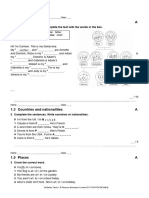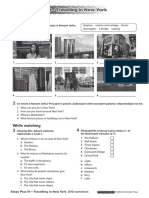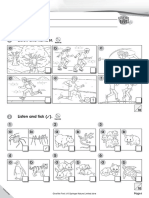0 ratings0% found this document useful (0 votes)
101 viewsSB 11847
SB 11847
Uploaded by
Camyla DávilaThe document provides instructions for an activity where students read and match names to roles like queen, wizard, and king. It then has students circle whether statements about roles are true or false, and complete sentences by filling in pronouns to refer to people with different roles like witch, princess, prince, and queen.
Copyright:
© All Rights Reserved
Available Formats
Download as PDF, TXT or read online from Scribd
SB 11847
SB 11847
Uploaded by
Camyla Dávila0 ratings0% found this document useful (0 votes)
101 views1 pageThe document provides instructions for an activity where students read and match names to roles like queen, wizard, and king. It then has students circle whether statements about roles are true or false, and complete sentences by filling in pronouns to refer to people with different roles like witch, princess, prince, and queen.
Original Description:
New Treetops 2 Revision
Original Title
Sb 11847
Copyright
© © All Rights Reserved
Available Formats
PDF, TXT or read online from Scribd
Share this document
Did you find this document useful?
Is this content inappropriate?
The document provides instructions for an activity where students read and match names to roles like queen, wizard, and king. It then has students circle whether statements about roles are true or false, and complete sentences by filling in pronouns to refer to people with different roles like witch, princess, prince, and queen.
Copyright:
© All Rights Reserved
Available Formats
Download as PDF, TXT or read online from Scribd
Download as pdf or txt
0 ratings0% found this document useful (0 votes)
101 views1 pageSB 11847
SB 11847
Uploaded by
Camyla DávilaThe document provides instructions for an activity where students read and match names to roles like queen, wizard, and king. It then has students circle whether statements about roles are true or false, and complete sentences by filling in pronouns to refer to people with different roles like witch, princess, prince, and queen.
Copyright:
© All Rights Reserved
Available Formats
Download as PDF, TXT or read online from Scribd
Download as pdf or txt
You are on page 1of 1
Unit 1 Name
1 Read and match.
1 She’s a queen.
b
2 He’s a wizard. a
c
3 She’s a witch.
4 He’s a knight.
5 He’s a king. d e
2 Circle the correct answer.
1 Is he a knight? Yes, he is. / No, he isn’t.
2 Is she a princess? Yes, she is. / No, she isn’t.
3 Is she a dragon? Yes, she is. / No, she isn’t.
4 Is he a prince? Yes, he is. / No, he isn’t.
3 Complete the sentences with She’s, He’s, His and Her.
1 2 3 4
1 She’s a witch. Her name’s Olivia .
2 a princess. name’s Isis .
3 a prince. name’s Harry .
4 a queen. name’s Laya .
revision Photocopiable © Oxford University Press New Treetops 4
You might also like
- 1 Blue Unit 1Document1 page1 Blue Unit 1Diana CadenaNo ratings yet
- Eyes Open 4 Unit 1 ReviewDocument7 pagesEyes Open 4 Unit 1 ReviewRenan CarvalhoNo ratings yet
- NTT 3 Activity Revision Unit01Document1 pageNTT 3 Activity Revision Unit01Camyla DávilaNo ratings yet
- NTT 4 Activity Extension Unit01Document1 pageNTT 4 Activity Extension Unit01Camyla DávilaNo ratings yet
- Explore Treetops Klasa III. Test Unit 1Document4 pagesExplore Treetops Klasa III. Test Unit 1kapskamalgorzataNo ratings yet
- NTT 3 Activity Revision Unit08 PDFDocument1 pageNTT 3 Activity Revision Unit08 PDFCamyla DávilaNo ratings yet
- NTT 4 Activity Revision Unit06Document1 pageNTT 4 Activity Revision Unit06Camyla DávilaNo ratings yet
- NTT 4 Activity Revision Unit03Document1 pageNTT 4 Activity Revision Unit03Camyla DávilaNo ratings yet
- ECA1 - Tests - End-of-Year Test BDocument2 pagesECA1 - Tests - End-of-Year Test BKrystyna ŁukasikNo ratings yet
- Link L4 U7 Extension WsDocument1 pageLink L4 U7 Extension WsKatarzyna BarankiewiczNo ratings yet
- ECA1 - Tests - Vocabulary Check 6ADocument1 pageECA1 - Tests - Vocabulary Check 6Aagata.skoczek92No ratings yet
- ECA1 - Tests - End-of-Year Test A - New2018Document4 pagesECA1 - Tests - End-of-Year Test A - New2018Marta Bloch-PogodzińskaNo ratings yet
- Explore Treetops Klasa III.Document1 pageExplore Treetops Klasa III.KasiaNo ratings yet
- NTT 4 Activity Extension Unit04Document1 pageNTT 4 Activity Extension Unit04Camyla DávilaNo ratings yet
- NTT 4 Activity Extension Unit02Document1 pageNTT 4 Activity Extension Unit02Camyla DávilaNo ratings yet
- Brainy Kl5 Final Test BDocument3 pagesBrainy Kl5 Final Test BAlicja kaczmarekNo ratings yet
- Steps Plus4 Unit Tests AK - WEBDocument9 pagesSteps Plus4 Unit Tests AK - WEBAnna SzczepańskaNo ratings yet
- Vocabulary Check 1ACHECKEDDocument2 pagesVocabulary Check 1ACHECKEDSole BarriaNo ratings yet
- super heroes 3 unit 2 sortowanie wyrazowDocument2 pagessuper heroes 3 unit 2 sortowanie wyrazowPatrycja JasińskaNo ratings yet
- NTT 3 Activity Revision Unit07Document1 pageNTT 3 Activity Revision Unit07Camyla DávilaNo ratings yet
- Treetops 3 TestsDocument22 pagesTreetops 3 TestsLeon KubiakNo ratings yet
- Action VerbsDocument1 pageAction VerbsmbbmdrNo ratings yet
- Link L4 U2 Unit TestcDocument2 pagesLink L4 U2 Unit TestcJulia ŚliwaNo ratings yet
- Super Sparks 2 - Klasa 2 Ćwiczenia Dodatkowe - 0Document25 pagesSuper Sparks 2 - Klasa 2 Ćwiczenia Dodatkowe - 0Яна ШкварченкоNo ratings yet
- ECA1 Tests Vocabulary Check 8A New2018Document1 pageECA1 Tests Vocabulary Check 8A New2018Malwina SNo ratings yet
- ECA1 - Tests - Language Test 6A - New2018 - 230522 - 000657Document5 pagesECA1 - Tests - Language Test 6A - New2018 - 230522 - 000657Irena OleniczNo ratings yet
- ECA1 - Tests - End-of-Year Test C - New2018Document5 pagesECA1 - Tests - End-of-Year Test C - New2018Marta Bloch-PogodzińskaNo ratings yet
- The Weather Worksheet Templates Layouts - 28349Document3 pagesThe Weather Worksheet Templates Layouts - 28349NataliaNo ratings yet
- ECA1 - Tests - End-of-Year Test B - New2018 (1) - 230224 - 171651Document5 pagesECA1 - Tests - End-of-Year Test B - New2018 (1) - 230224 - 171651Irena OleniczNo ratings yet
- Tiger&Friends 2 - TRF - Unit 1 - Early Finish Plus 1Document1 pageTiger&Friends 2 - TRF - Unit 1 - Early Finish Plus 1aleksandra.burczyk1986No ratings yet
- ECA1 - Tests - Skills Test 7-8ADocument2 pagesECA1 - Tests - Skills Test 7-8AGrzegorz RóżalskiNo ratings yet
- NTT 3 Activity Revision Unit03Document1 pageNTT 3 Activity Revision Unit03Camyla DávilaNo ratings yet
- Christmas Cross WordsDocument6 pagesChristmas Cross WordsPoirierNo ratings yet
- Brainy 7, Unit 1 ABDocument4 pagesBrainy 7, Unit 1 ABNatalia Góra100% (1)
- 04 WQuest 2 Progress Test U7-8Document3 pages04 WQuest 2 Progress Test U7-8Magdalena QuirogaNo ratings yet
- 11 ECA1 - Tests - Language Test 6A - 230522 - 000448Document2 pages11 ECA1 - Tests - Language Test 6A - 230522 - 000448Irena OleniczNo ratings yet
- Brainy 4 Progress Tests Answer KeyDocument2 pagesBrainy 4 Progress Tests Answer KeyMonika AstachowNo ratings yet
- GMF L3 Vocabulary PracticeDocument9 pagesGMF L3 Vocabulary PracticemarkelovfyodorNo ratings yet
- Steps Plus Dla Klasy VI DVD Worksheet 1 New YorkDocument2 pagesSteps Plus Dla Klasy VI DVD Worksheet 1 New YorkMonika aqwerNo ratings yet
- Link L4 U5 Reinforcement WsDocument1 pageLink L4 U5 Reinforcement WsJoanna MajczykNo ratings yet
- NTT 2 Activity Revision Unit03Document1 pageNTT 2 Activity Revision Unit03Camyla DávilaNo ratings yet
- New Hot Spot 2 Module 2 Test A PDFDocument2 pagesNew Hot Spot 2 Module 2 Test A PDFSzymonNo ratings yet
- GMF L3 Diagnostic TestDocument4 pagesGMF L3 Diagnostic Testprzybylo.annamonikaNo ratings yet
- Link L5 U6 Extension WsDocument1 pageLink L5 U6 Extension WsluNo ratings yet
- Link L4 U1 Unit TestcDocument2 pagesLink L4 U1 Unit TestcSebastian BrzezińskiNo ratings yet
- Link L4 U3 Unit TestdDocument2 pagesLink L4 U3 Unit Testdklipinski274No ratings yet
- L5 - Final TestDocument5 pagesL5 - Final TestSam Fleming100% (1)
- ECA1 - Tests - Language Test 3C - New2018Document8 pagesECA1 - Tests - Language Test 3C - New2018Grzegorz RóżalskiNo ratings yet
- Smart Junior 4 Test 4Document1 pageSmart Junior 4 Test 4zaytseva.zhesyaNo ratings yet
- Link_L5_U3_5min_test_grammarDocument1 pageLink_L5_U3_5min_test_grammarElwira NiecieckaNo ratings yet
- Brainy 5 Unit Test 7 BDocument2 pagesBrainy 5 Unit Test 7 BMarcel LewuszNo ratings yet
- ECA1 - Tests - Mid-Year Test A - New2018Document4 pagesECA1 - Tests - Mid-Year Test A - New2018Marta Bloch-PogodzińskaNo ratings yet
- ECA1 - Tests - Language Test 1BDocument1 pageECA1 - Tests - Language Test 1BKarolinaNo ratings yet
- Link L4 U2 Unit TestbDocument2 pagesLink L4 U2 Unit TestbSebastian BrzezińskiNo ratings yet
- U6 l2 Practice PDFDocument1 pageU6 l2 Practice PDFCarolNo ratings yet
- Link L8 U3 5min Test VocabDocument1 pageLink L8 U3 5min Test VocabKatarzyna SzkodzińskaNo ratings yet
- ECA1 - Tests - Skills Test 1-2BDocument2 pagesECA1 - Tests - Skills Test 1-2BGrzegorz RóżalskiNo ratings yet
- WORKSHEETSDocument16 pagesWORKSHEETSLilia Loyaga DominguezNo ratings yet
- Vocabulary Check 2ADocument2 pagesVocabulary Check 2ABeata WesolowskaNo ratings yet
- Unit 1 PDFDocument1 pageUnit 1 PDFIzabela WawrzonkiewiczNo ratings yet
- YTT - 3 - Unit 1 - TestDocument2 pagesYTT - 3 - Unit 1 - Testkatarzynamroz78No ratings yet
- NTT 3 Activity Extension Unit01Document1 pageNTT 3 Activity Extension Unit01Camyla DávilaNo ratings yet
- NTT 3 Activity Revision Unit07Document1 pageNTT 3 Activity Revision Unit07Camyla DávilaNo ratings yet
- NTT 2 Activity Revision Unit02Document1 pageNTT 2 Activity Revision Unit02Camyla DávilaNo ratings yet
- NTT 2 Activity Revision Unit03Document1 pageNTT 2 Activity Revision Unit03Camyla DávilaNo ratings yet
- NTT 3 Activity Extension Unit04Document1 pageNTT 3 Activity Extension Unit04Camyla Dávila100% (1)
- NTT 3 Activity Revision Unit03Document1 pageNTT 3 Activity Revision Unit03Camyla DávilaNo ratings yet
- NTT 4 Activity Extension Unit02Document1 pageNTT 4 Activity Extension Unit02Camyla DávilaNo ratings yet
- NTT 2 Activity Revision Unit05Document1 pageNTT 2 Activity Revision Unit05Camyla DávilaNo ratings yet
- NTT 2 Activity Revision Unit04Document1 pageNTT 2 Activity Revision Unit04Camyla DávilaNo ratings yet
- NTT 2 Activity Extension Unit04Document1 pageNTT 2 Activity Extension Unit04Camyla DávilaNo ratings yet
- NTT 4 Activity Extension Unit04Document1 pageNTT 4 Activity Extension Unit04Camyla DávilaNo ratings yet
- NTT 4 Activity Extension Unit06Document1 pageNTT 4 Activity Extension Unit06Camyla DávilaNo ratings yet



































































